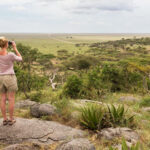LAKE MANYARA NATIONAL PARK
Lake Manyara National Park is a well-known park in northern Tanzania, East Africa. It has a surface area of around 325 square kilometers (125 square miles) and is part of the wider Manyara ecosystem, which encompasses the lake and its surroundings.
Lake Manyara National Park, a shallow alkaline lake that runs along the park’s western perimeter, is the park’s focal point. The lake draws several bird species, including flamingos, pelicans, storks, and other waterfowl. It is a bird watcher’s heaven, with amazing opportunities for bird watching and photography.
The park is also well-known for its abundant biodiversity. Although it is modest in comparison to other Tanzanian parks, it is home to a diverse array of wildlife. Elephants, buffalos, giraffes, zebras, wildebeests, and many antelope species such as impalas and gazelles can be seen. The park is well-known for its tree-climbing lions, which may frequently be seen relaxing on the branches of acacia trees.

Lake Manyara National Park’s vegetation is a combination of dense forests, open grassy plains, and marshes. The park’s various ecosystems support a wide range of animals and fauna. The park, in addition to the lake and its surrounds, includes the Great Rift Valley escarpment, which contributes to the visual splendour and provides stunning views.
Game drives, bird watching, walking safaris, and cultural trips to surrounding Maasai villages are all available within the park. The park is relatively accessible and is frequently included on the classic northern circuit safari itinerary, which also includes the Serengeti National Park and Ngorongoro Crater.

Lake Manyara National Park, with its gorgeous scenery, plentiful wildlife, and outstanding fauna, provides a unique and memorable safari experience, making it a must-visit location in Tanzania for nature enthusiasts and wildlife lovers.


